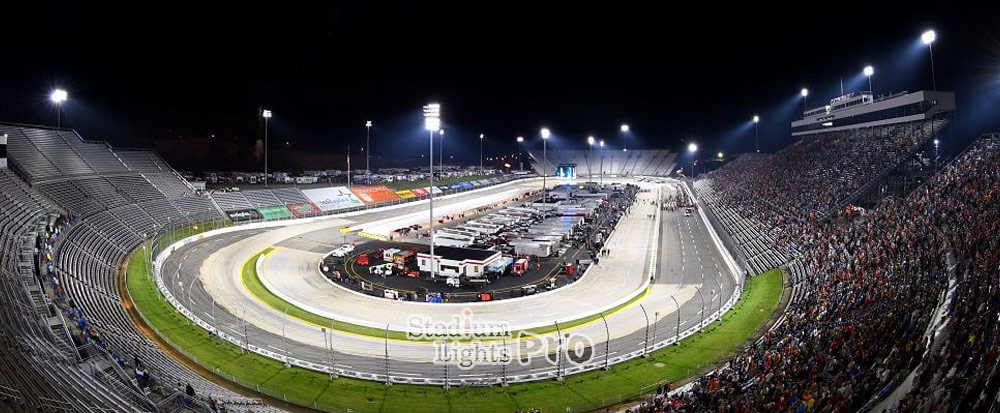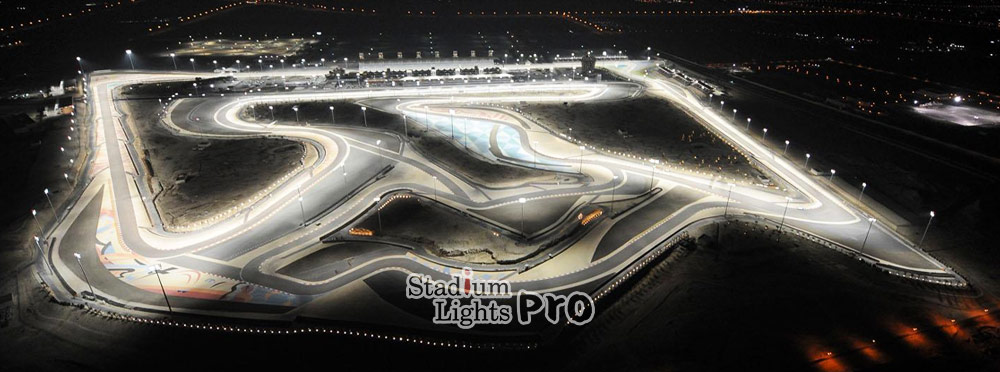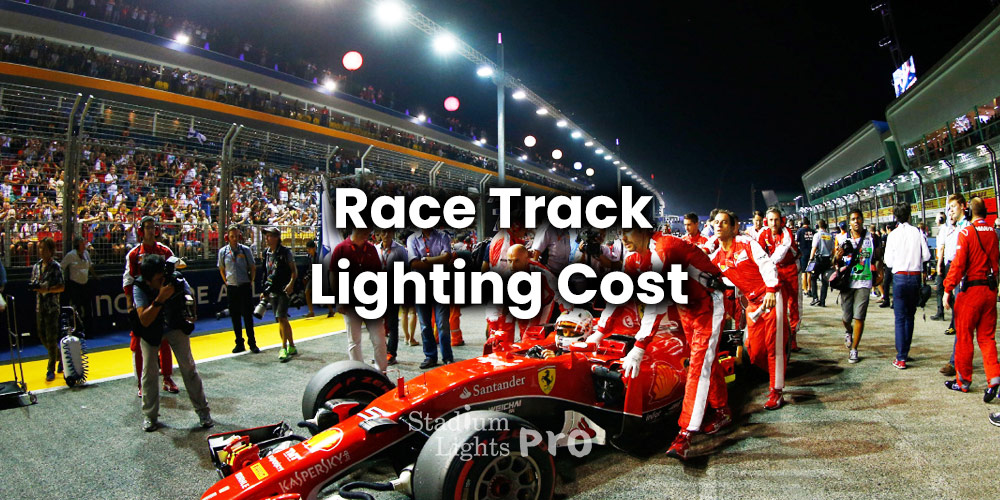In terms of safety, lighting is crucial for ensuring that drivers can see the track and any potential hazards ahead of them, such as other cars or debris. This is especially essential during night races, when natural lighting is not sufficient. Proper lighting can also help to improve the visibility of trackside personnel, such as marshals and pit crew members, which can help to prevent accidents and incidents.
In terms of spectator experience, lighting can help to create a more immersive and visually appealing atmosphere at races, particularly during night events.
Table of Contents
ToggleCost of race track lighting

As a race track owner or facility manager, understanding the cost to light a race track is necessary. Here, we provide an estimate of the associated expenses for your reference.
Lighting fixtures
The cost of the lighting fixtures will depend on the type of lighting used. For example, traditional metal halide or high-pressure sodium lights can cost around $1,000 to $2,000 per fixture, while LED lights can cost anywhere from $500 to $1,500 per fixture. For a 1-mile oval track, it’s likely that you would need at least 100-150 fixtures, so the total cost for lighting fixtures could be anywhere from $50,000 to $300,000.
Electrical work
The cost of electrical work will depend on the complexity of the project, as well as local labor rates. This could include running power to the lighting fixtures, installing control systems, and other necessary electrical work. The cost of electrical work could be anywhere from $20,000 to $50,000.
Power supply
The cost of running power to the lighting fixtures, including the cost of any necessary trenching or underground work, can add to the cost of electrical work.
Control systems
The cost of installing control systems that allow the lights to be dimmed or turned on and off remotely can also add to the cost of electrical work.
Wiring and connections
The cost of wiring and connecting the lighting fixtures to the power supply and control systems can also add to the cost of electrical work.
Permits and inspections
Depending on local regulations, there may be costs associated with obtaining permits and passing inspections for the lighting installation. These costs can vary widely depending on location, but could be anywhere from $5,000 to $20,000.
The cost of permits and inspections for race track lighting can vary depending on local regulations and the complexity of the project. Some of the factors that can affect the cost include:
Local regulations
Different municipalities have different regulations and requirements for lighting installations, which can affect the cost of permits and inspections.
Project complexity
The more complex the lighting project, the more permits and inspections may be required, which can increase the cost.
Professional fees
Hiring an engineer or consultant to help with the permit and inspection process can add to the cost.
Labor
The cost of labor will depend on the complexity of the project and the skill level of the workers. This could include the cost of installing the lighting fixtures, electrical work, and any other necessary labor. The cost of labor could be anywhere from $10,000 to $30,000.
Factors that affect race track lighting costs
Size of the track

A larger track will require more lights to adequately illuminate the surface and surrounding areas, which will increase the overall cost.
For example, a small club racing track with a length of a few hundred meters may only require a few dozen lights, while a major international racing circuit with a length of several kilometers may require hundreds or even thousands of lights.
Besides the length of the track, other factors such as the width of the track and the layout of the circuit can also impact the number of lights needed. For example, a track with many tight turns and complex layout may require more lights to adequately illuminate the entire surface.
Number of lights
The number of lights needed at a race track will depend on the size of the track and the desired level of illumination. A larger track will require more lights to adequately light the surface and surrounding areas, while a smaller track will need fewer lights.
The number of lights needed can also be influenced by the layout of the track and the presence of natural light. A track with many tight turns and complex layout may require more lights to adequately illuminate the entire surface, while a track with long straights and few turns may need fewer lights. Additionally, if the track is located in an area with low levels of natural light, such as in a valley or on a cloudy day, more lights may be needed to provide sufficient illumination.
Type of lighting technology
The type of race track lighting used at a race track can have a significant impact on the cost of installation and maintenance. Different lighting technologies have different costs associated with them, and choosing the right technology can help to minimize costs over the long term.
Incandescent lights
Incandescent lights are traditional bulbs that use a filament to produce light. They are generally cheaper to purchase than other types of lighting, but they are less energy efficient and have shorter lifespans, which can increase the overall cost of lighting a track in the long term.
Fluorescent lights
Fluorescent lights use a gas-discharge process to produce light and are generally more energy efficient than incandescent lights. They also have longer lifespans, which can reduce the cost of maintenance. However, they may be more expensive to purchase upfront compared to incandescent lights.
LED lights
LED lights use light-emitting diodes to produce light and are widely considered to be the most energy-efficient and long-lasting lighting technology available. They are generally more expensive to purchase upfront than other types of lighting, but they can save money in the long term due to their energy efficiency and longer lifespan.
Location of the track
Availability of electricity

If the track is located in an area with a reliable power grid, the cost of lighting may be lower. If the track is located in a remote area or is not connected to the power grid, the cost of lighting may be higher due to the need for generators or other off-grid power solutions.
Local climate
For example, a track located in a hot and humid climate may require more frequent maintenance of the lighting system due to the effects of corrosion and moisture on the equipment. Conversely, a track located in a dry and arid climate may experience less wear and tear on the lighting system, which can reduce maintenance costs.
Natural light
If the track is located in an area with high levels of natural light, such as in a sunny region or at high altitude, fewer lights may be needed to provide sufficient illumination. This can reduce the overall cost of lighting the track.
Maintenance requirements
Different lighting technologies have different maintenance requirements, and choosing the right technology can help to minimize maintenance costs over the long term.
Lifespan
Different lighting technologies have different lifespans, which can affect the frequency of replacement and the overall cost of maintenance. For example, LED lights have a longer lifespan compared to traditional incandescent lights, which means they need to be replaced less frequently and can reduce maintenance costs over the long term.
Energy efficiency
Energy-efficient lighting technologies can help to reduce the overall cost of lighting a race track by reducing energy consumption and lowering energy bills. Lighting technologies such as LED lights are widely considered to be the most energy efficient and can help to reduce the cost of lighting a track in the long term.
Durability
The durability of a lighting system can also impact its maintenance requirements. Lighting systems that are prone to wear and tear or damage from weather or other external factors may require more frequent maintenance and replacement, which can increase costs.
Funding options of race track lighting
There are several options for funding the installation and maintenance of race track lighting, including:
Government grants
Government grants are financial awards provided by government agencies to support the development and improvement of sporting facilities, including race tracks. These grants may be available to cover the cost of installing and maintaining lighting at a track, and they can be a useful source of funding for tracks that are looking to improve their facilities.
Government grants are typically competitive and may have specific eligibility criteria that must be met in order to be considered. For example, the grant may be available only to tracks that meet certain safety standards or are located in a certain geographic area. Grants may also be subject to certain terms and conditions, such as requiring the track to maintain certain standards or to use the funds for specific purposes.
To apply for a government grant, a race track will typically need to submit a grant application, which may require detailed information about the track and its proposed lighting project, as well as a budget and plan for how the funds will be used. The grant application may also require supporting documents, such as financial statements or proof of ownership of the track.
Government grants can be a useful source of funding for race track lighting, but they may be competitive and may require a significant amount of time and effort to apply for and secure.
Private sponsorships
Private sponsorships are financial or in-kind contributions provided by private companies or organizations to support the development and improvement of sporting facilities, including race tracks. Private sponsorships may be used to fund the installation and maintenance of lighting at a track in exchange for exposure and branding opportunities.
It can be a cost-effective way to fund the lighting system at a race track, as they can help to offset the costs and provide additional resources for the track. Sponsors may be interested in supporting a track for a variety of reasons, such as to promote their brand, to support the local community, or to showcase their products or services.
To secure a private sponsorship, a race track will typically need to approach potential sponsors and pitch them on the benefits of supporting the track. This may involve presenting a detailed proposal that outlines the track’s needs and how the sponsorship will be used, as well as the benefits that the sponsor will receive in return, such as exposure through signage or advertising at the track.
Private sponsorships can be a valuable source of funding for race track lighting, but they may be competitive and may require a significant amount of time and effort to secure.
Crowdfunding campaigns
Crowdfunding campaigns are a way to raise funds for a specific project or cause by seeking small contributions from a large number of people. Crowdfunding campaigns can be a useful way for race tracks to fund the installation and maintenance of lighting by seeking small donations from racing fans and other supporters.
There are several platforms available for launching crowdfunding campaigns, including online platforms such as Kickstarter and GoFundMe, as well as more specialized platforms that focus on sports and athletics. To launch a crowdfunding campaign, a race track will typically need to create a campaign page on the platform of their choice and provide information about the track and its lighting project, as well as a budget and plan for how the funds will be used. The campaign page may also include perks or rewards for donors, such as merchandise or exclusive experiences at the track.
Crowdfunding campaigns can be a cost-effective way to fund race track lighting, as they can help to cover the costs of the project without requiring a large upfront investment. However, it can be challenging to reach the fundraising goals of a crowdfunding campaign, and it may require a significant amount of time and effort to promote the campaign and encourage donations.
Self-funding
Self-funding is a way for a race track to fund the installation and maintenance of lighting through its own resources, such as ticket sales or other revenues. This can be a cost-effective option if the track has sufficient financial resources, but it may not be feasible for smaller tracks or those with limited budgets.
There are several ways that a race track can self-fund the installation and maintenance of lighting, including:
Ticket sales
Ticket sales can be a significant source of revenue for race tracks, and some tracks may choose to use a portion of their ticket sales to fund the installation and maintenance of lighting.
Merchandise sales
Race tracks may also generate revenue from the sale of merchandise, such as t-shirts, hats, and other items, which can be used to fund the lighting system.
Advertising and sponsorships
Race tracks may also generate revenue from advertising and sponsorships, such as through signage or advertising at the track, which can be used to fund the lighting system.
Grants and loans
Race tracks may also be able to secure grants or loans to fund the installation and maintenance of lighting, which can be repaid over time with track revenues.
Conclusion
The cost of race track lighting can be influenced by a variety of factors, including the size of the track, the number of lights needed, the type of lighting technology used, the location of the track, and the maintenance requirements.
If you’re looking to improve the lighting at your race track and want to explore your options, our team of experienced engineers is here to help. We offer free design services for race track lighting to help you determine the best solution for your track.
Whether you need to install a new lighting system or upgrade an existing one, our team can help you create a customized design that meets your specific needs and budget. We have a deep understanding of the unique challenges and requirements of race track lighting and can provide expert guidance on the best technologies and approaches to use.
If you’re interested in getting a free design for race track lighting, please don’t hesitate to contact us. Our team is always ready to help and is happy to answer any questions you may have. We look forward to working with you to create a lighting system that enhances the safety and enjoyment of races for both drivers and spectators.

